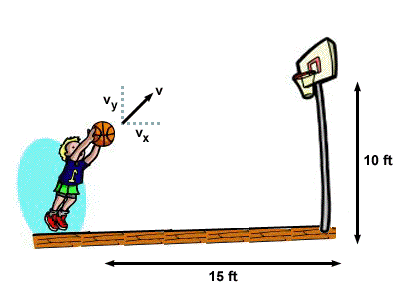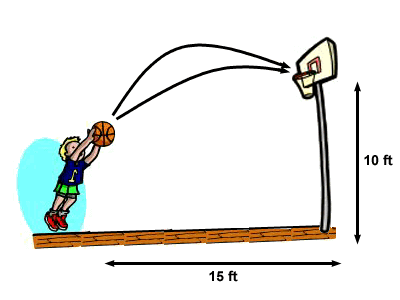Problem :
A basketball player who is standing 15 feet away from a basketball hoop is
trying to make a basket. If the height of the hoop is 10 feet, and the
height at which the player shoots the ball is 6 feet, at what angle and with
what speed should the player shoot the ball?

Using the general formula for projectile motion worked out in this section, we find that the position function for a ball which is shot from a height of 6ft, with initial velocity vector v0, is:
 (0, 0, - g)t2 + v0t + (0, 0, 6)
(0, 0, - g)t2 + v0t + (0, 0, 6)
For the player to make his basket, the trajectory of the ball must pass through the point (15, 0, 10) (since the basket is located 15 ft away and is 10 ft high). Therefore, we need to find v0 = (vx, 0, vz) such that x(t) = (15, 0, 10) at some time t (since there is no motion in the y-direction we know that vy must be zero). To do this, we write out the one-dimensional equations for the x- and z-directions:
(1) 15 = vxt, and (2) 10 = -gt2 + vzt + 6
From (2) we find that the ball reaches a height of 10 ft at a time t such that:
 gt2 - vzt + 4 = 0
gt2 - vzt + 4 = 0
 and t2 =
and t2 =  .
.
It is not enough for the ball to have a height of 10 ft, however, in order for the basketball player to make the basket. At the same time it reaches that height (i.e. at time t1) it must also have traveled 15 ft in the x- direction. We are now in a position to solve for vx in terms of vz. Using (1), and plugging in the time t1, we find that:
 =
= 
 , 0, vz)
, 0, vz)

 is a real number), there is a
solution. You were probably already aware of this intuitively because by
shooting a basketball at different angles and with different speeds you are
able to make the same basket in a variety of ways!
is a real number), there is a
solution. You were probably already aware of this intuitively because by
shooting a basketball at different angles and with different speeds you are
able to make the same basket in a variety of ways!
Problem : Assume that the basketball player in the previous problem has a special condition which allows him only to shoot basketballs at a speed of 10 ft/s. How might someone go about finding at what angle must he shoot the ball in order to make the basket?
Using the solution to the previous problem, , 0, vz)
, 0, vz)


 payment page
payment page



